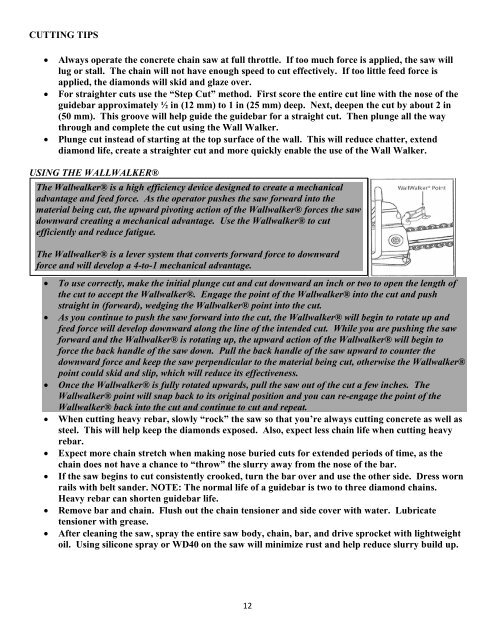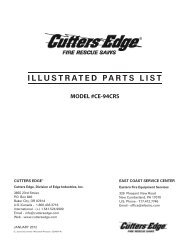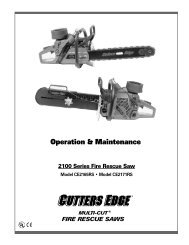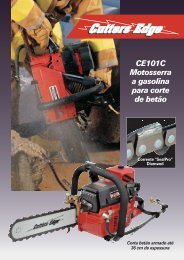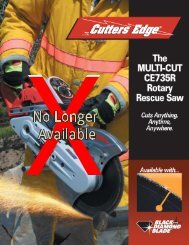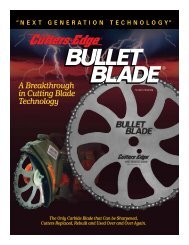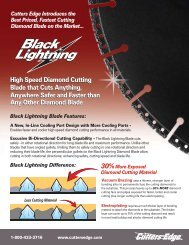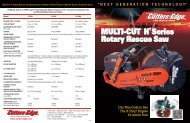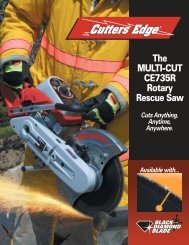introduction - Cutters Edge
introduction - Cutters Edge
introduction - Cutters Edge
Create successful ePaper yourself
Turn your PDF publications into a flip-book with our unique Google optimized e-Paper software.
CUTTING TIPS<br />
• Always operate the concrete chain saw at full throttle. If too much force is applied, the saw will<br />
lug or stall. The chain will not have enough speed to cut effectively. If too little feed force is<br />
applied, the diamonds will skid and glaze over.<br />
• For straighter cuts use the “Step Cut” method. First score the entire cut line with the nose of the<br />
guidebar approximately ½ in (12 mm) to 1 in (25 mm) deep. Next, deepen the cut by about 2 in<br />
(50 mm). This groove will help guide the guidebar for a straight cut. Then plunge all the way<br />
through and complete the cut using the Wall Walker.<br />
• Plunge cut instead of starting at the top surface of the wall. This will reduce chatter, extend<br />
diamond life, create a straighter cut and more quickly enable the use of the Wall Walker.<br />
USING THE WALLWALKER®<br />
The Wallwalker® is a high efficiency device designed to create a mechanical<br />
advantage and feed force. As the operator pushes the saw forward into the<br />
material being cut, the upward pivoting action of the Wallwalker® forces the saw<br />
downward creating a mechanical advantage. Use the Wallwalker® to cut<br />
efficiently and reduce fatigue.<br />
The Wallwalker® is a lever system that converts forward force to downward<br />
force and will develop a 4-to-1 mechanical advantage.<br />
• To use correctly, make the initial plunge cut and cut downward an inch or two to open the length of<br />
the cut to accept the Wallwalker®. Engage the point of the Wallwalker® into the cut and push<br />
straight in (forward), wedging the Wallwalker® point into the cut.<br />
• As you continue to push the saw forward into the cut, the Wallwalker® will begin to rotate up and<br />
feed force will develop downward along the line of the intended cut. While you are pushing the saw<br />
forward and the Wallwalker® is rotating up, the upward action of the Wallwalker® will begin to<br />
force the back handle of the saw down. Pull the back handle of the saw upward to counter the<br />
downward force and keep the saw perpendicular to the material being cut, otherwise the Wallwalker®<br />
point could skid and slip, which will reduce its effectiveness.<br />
• Once the Wallwalker® is fully rotated upwards, pull the saw out of the cut a few inches. The<br />
Wallwalker® point will snap back to its original position and you can re-engage the point of the<br />
Wallwalker® back into the cut and continue to cut and repeat.<br />
• When cutting heavy rebar, slowly “rock” the saw so that you’re always cutting concrete as well as<br />
steel. This will help keep the diamonds exposed. Also, expect less chain life when cutting heavy<br />
rebar.<br />
• Expect more chain stretch when making nose buried cuts for extended periods of time, as the<br />
chain does not have a chance to “throw” the slurry away from the nose of the bar.<br />
• If the saw begins to cut consistently crooked, turn the bar over and use the other side. Dress worn<br />
rails with belt sander. NOTE: The normal life of a guidebar is two to three diamond chains.<br />
Heavy rebar can shorten guidebar life.<br />
• Remove bar and chain. Flush out the chain tensioner and side cover with water. Lubricate<br />
tensioner with grease.<br />
• After cleaning the saw, spray the entire saw body, chain, bar, and drive sprocket with lightweight<br />
oil. Using silicone spray or WD40 on the saw will minimize rust and help reduce slurry build up.<br />
12


